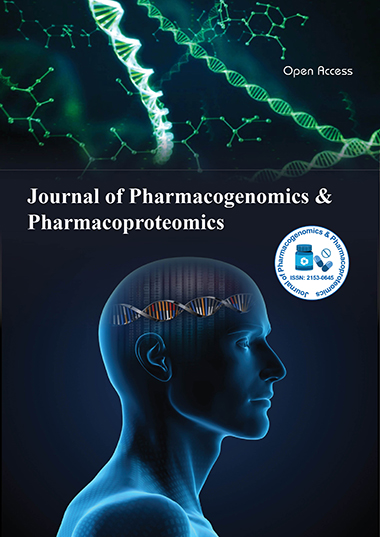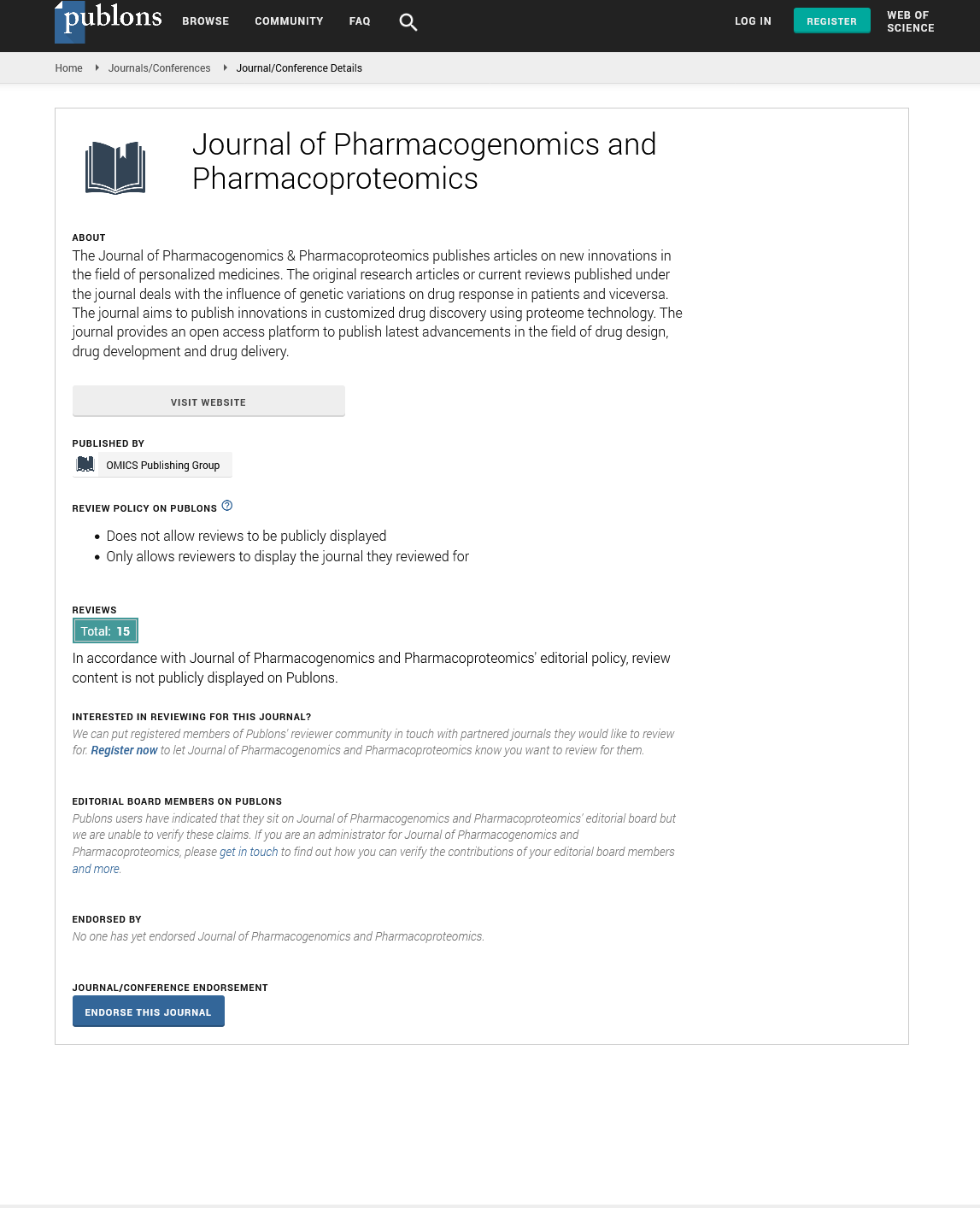Indexed In
- Open J Gate
- Genamics JournalSeek
- Academic Keys
- JournalTOCs
- ResearchBible
- Electronic Journals Library
- RefSeek
- Hamdard University
- EBSCO A-Z
- OCLC- WorldCat
- Proquest Summons
- SWB online catalog
- Virtual Library of Biology (vifabio)
- Publons
- MIAR
- Euro Pub
- Google Scholar
Useful Links
Share This Page
Journal Flyer

Open Access Journals
- Agri and Aquaculture
- Biochemistry
- Bioinformatics & Systems Biology
- Business & Management
- Chemistry
- Clinical Sciences
- Engineering
- Food & Nutrition
- General Science
- Genetics & Molecular Biology
- Immunology & Microbiology
- Medical Sciences
- Neuroscience & Psychology
- Nursing & Health Care
- Pharmaceutical Sciences
Commentary - (2025) Volume 16, Issue 2
Pharmacogenomics and Pharmacoproteomics as Dual Pillars of Precision Medicine
Ayesha Rahman*Received: 02-Jun-2025, Manuscript No. JPP-25-29913; Editor assigned: 04-Jun-2025, Pre QC No. JPP-25-29913 (PQ); Reviewed: 16-Jun-2025, QC No. JPP-25-29913; Revised: 23-Jun-2025, Manuscript No. JPP-25-29913 (R); Published: 30-Jun-2025, DOI: 10.4172/2153-0645.25.16.135
Description
Pharmacogenomics and pharmacoproteomics are two interconnected disciplines that together hold the promise of revolutionizing modern medicine through the principles of precision health. While pharmacogenomics examines the influence of genetic variation on drug response, pharmacoproteomics expands the understanding by analyzing how proteins, the functional products of genes, interact with drugs and influence outcomes. The combination of these two approaches allows for a more holistic view of patient variability, leading to therapies that are safer, more effective, and tailored to individual biological profiles.
Genetic variability has long been known to contribute to differences in drug efficacy and adverse reactions. Certain polymorphisms in genes encoding drug-metabolizing enzymes, transporters, and receptors determine whether a drug will be metabolized quickly, slowly, or not at all. Pharmacogenomics brings these variations to light, enabling clinicians to predict drug responses before prescribing. Yet genes are only part of the story. Proteins, as the active players in most biological processes, directly determine how drugs act in the body.
Pharmacoproteomics examines protein abundance, structure, modifications, and interactions, thus offering insight into mechanisms that cannot be explained by genetics alone. Together, they bridge the gap between genetic predisposition and actual physiological outcomes.
The clinical implications of integrating pharmacogenomics and pharmacoproteomics are profound. For example, in oncology, patients often exhibit variable responses to chemotherapeutic agents. Pharmacogenomic testing might reveal mutations in genes such as CYP2D6 or TPMT, predicting differences in drug metabolism. Simultaneously, Pharmacoproteomic analyses can identify protein biomarkers associated with resistance pathways, such as overexpression of efflux transporters or alterations in signaling cascades. A combined approach ensures that oncologists not only select the correct drug but also anticipate resistance, adapt dosing strategies, and monitor treatment efficacy in real time.
One of the most exciting aspects of pharmacoproteomics lies in its reliance on cutting-edge technologies such as mass spectrometry, protein microarrays, and bioinformatics-driven systems biology. These techniques allow researchers to quantify thousands of proteins simultaneously, map their interactions, and track changes in response to therapy. Such dynamic insights complement the static information provided by genomics, which captures the inherited code but not the environmental and posttranslational influences on proteins. By bringing these two fields together, scientists can create predictive models of drug response that are both accurate and adaptable.
The application of pharmacogenomics and pharmacoproteomics is not limited to cancer. In cardiology, for instance, patients prescribed anticoagulants like warfarin or Clopidogrel often require close monitoring due to variable genetic determinants in CYP2C9, VKORC1, and P2Y12 receptor genes. Pharmacogenomic testing helps stratify patients into different dosing categories. However, protein-level changes in coagulation pathways, platelet activation, and inflammatory mediators provide equally critical information for optimizing therapy. Together, these insights reduce the risk of adverse bleeding or thrombotic events while ensuring therapeutic efficacy.
The ethical dimension of combining pharmacogenomics and pharmacoproteomics cannot be overlooked. With the growing ability to map both genetic and proteomic profiles, issues of privacy, consent, and data ownership become increasingly complex. Unlike a static genome, the proteome is dynamic and highly context-dependent, reflecting disease state, lifestyle, and environmental exposures. This makes proteomic data more sensitive, as it may reveal not just inherited predispositions but also real-time health conditions. Ethical frameworks must therefore evolve to safeguard patients’ rights while still allowing the immense potential of these technologies to be realized.
Looking ahead, the synergy between pharmacogenomics and pharmacoproteomics is expected to accelerate the development of next-generation therapies. Personalized drug regimens will increasingly consider both genetic predisposition and proteomic biomarkers, creating a feedback loop of continuous refinement. In infectious diseases, such integration could help tailor antibiotic therapy by considering both host and pathogen factors. In psychiatry, it may offer solutions to the longstanding problem of unpredictable responses to antidepressants and antipsychotics. In autoimmune disorders, dual-layered analyses could unravel the interplay between genetic susceptibility and protein-driven inflammatory cascades.
Citation: Rahman A (2025) Pharmacogenomics and Pharmacoproteomics as Dual Pillars of Precision Medicine. J Pharmacogenom Pharmacoproteomics. 16:135.
Copyright: ©2025 Rahman A. This is an open-access article distributed under the terms of the Creative Commons Attribution License, which permits unrestricted use, distribution and reproduction in any medium, provided the original author and source are credited.

